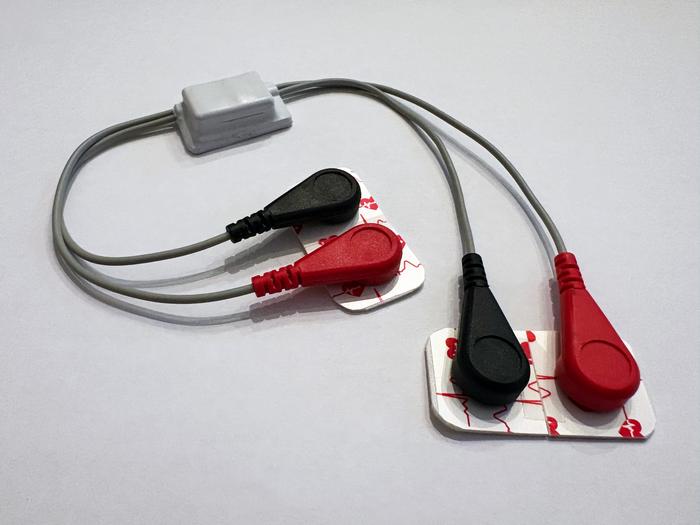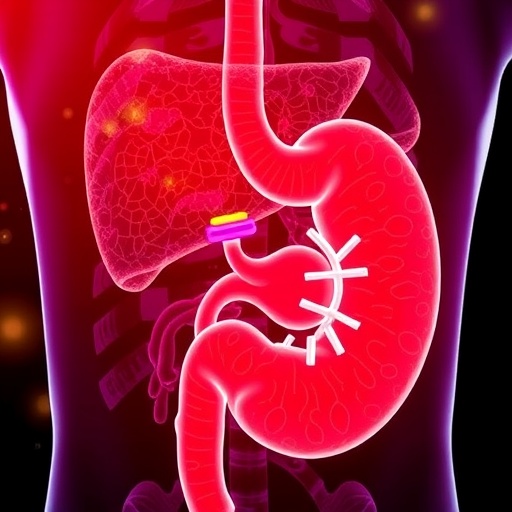A groundbreaking innovation from Northwestern University promises to transform the experience of breastfeeding by offering mothers an unprecedented window into the often invisible process of milk consumption. For years, one of the greatest challenges faced by breastfeeding mothers and healthcare providers alike has been the inability to accurately measure how much milk an infant receives during a nursing session. Addressing this critical gap, an interdisciplinary team of engineers, neonatologists, and pediatricians has developed a compact, wireless wearable device capable of providing continuous, clinical-grade monitoring of breast milk intake in real time.
This revolutionary device is designed as a thin, soft, and pliable cord that comfortably encircles the outer circumference of the breast during nursing. Embedded within the cord are gentle electrodes that adhere to the skin at both ends, while a small, lightweight base station resides securely at its center. This base station, encased in soft silicone, incorporates a rechargeable battery, Bluetooth technology for seamless wireless data transmission, and a memory chip to store continuous breastfeeding data. The unobtrusive nature of the device ensures that mothers experience little to no discomfort while it functions discreetly.
Before reaching clinical validation, the device underwent extensive theoretical and empirical testing. Initial stages involved benchtop experiments using anatomically inspired breast phantoms composed of materials simulating the distinct electrical conductivities of skin, fat, and milk. This modeling allowed engineers to meticulously observe how bioimpedance measurements changed as simulated milk volumes varied. Complementing these physical trials, advanced computer simulations incorporating patient-specific anatomy and tissue distribution were developed by computational modeling experts. These physics-based models were instrumental in predicting how sensor placement and individual breast variability impacted measurement accuracy, thus informing the optimal design and deployment of the device.
A pivotal aspect of its innovation lies in its personalization capability through a straightforward calibration process. Each user calibrates the device by wearing it during a pumping session involving measured milk volume collection. This procedure records the unique electrical signature corresponding to the volume of milk expressed, thereby teaching the device how changes in bioimpedance translate to actual milk consumption for each individual mother. This customization ensures high measurement precision regardless of variations in breast size, shape, or tissue density.
The clinical testing phase involved twelve breastfeeding mothers in both hospital settings and their homes over periods extending up to seventeen weeks. Mothers wore the device primarily during pumping, allowing researchers to cross-verify sensor data against the exact volume of milk expressed into bottles marked with precise measurements. Furthermore, in an illustrative trial, recorded milk consumption by the device correlated remarkably well with the gold standard method of weighing infants before and after feeding. These promising results not only demonstrate the device’s robustness but also its potential to replace cumbersome and inconvenient traditional approaches.
Beyond providing reassurance for all nursing parents, the device holds particular promise for fragile neonates in intensive care units. Premature and medically vulnerable infants have highly specific nutritional requirements, often complicated by underdeveloped digestive systems and feeding intolerance risks. Current practices sometimes preclude direct breastfeeding due to uncertainty about milk transfer, forcing reliance on bottle feeding or alternative interventions. This sensor technology could empower neonatologists and families to more safely support breastfeeding in NICU settings by offering real-time data on milk intake, thus fostering improved nutritional outcomes and maternal bonding.
The journey to this technological breakthrough was marked by extensive trial and error. Early attempts involved monitoring optical properties of the breast, tracking infant suckling motion, and analyzing swallowing events. However, these methods failed due to the complex anatomy, including the location of milk ducts deep beneath the skin. Ultimately, the adoption of bioimpedance sensing—a methodology widely used in medical fields to assess body composition by measuring electrical conductivity differences between tissues—proved the pathway to success. This innovative application highlights how interdisciplinary approaches can repurpose existing scientific principles to solve hitherto intractable healthcare challenges.
Experts involved express hope for the device’s future integration into everyday wearables such as specialized breastfeeding bras, increasing its convenience and acceptance among new mothers. There are also plans to enhance the sensor’s capabilities by enabling it to monitor milk refilling and production trends, as well as assess milk quality parameters like fat content. Such advancements could offer comprehensive insights into lactation physiology, supporting more informed decisions around breastfeeding management.
Clinical leaders emphasize that this technology addresses not only the technical problem of measuring milk intake but also the emotional and psychological stress often experienced by breastfeeding mothers. Anxiety and uncertainty about whether infants are receiving adequate nutrition can lead to frustration, depression, and premature cessation of breastfeeding. By eliminating guesswork and providing continuous, objective feedback, this device has the potential to improve maternal confidence, promote successful breastfeeding journeys, and ultimately contribute to healthier families and communities.
Ongoing collaboration across disciplines—spanning materials science, biomedical engineering, pediatrics, neonatology, and computational modeling—has been pivotal to realizing this milestone. The convergence of expertise from leading institutions such as Northwestern University and Rice University underscores the innovation power of cross-institutional partnerships. As this wearable breastfeeding monitor advances toward wider clinical adoption, it stands as a testament to the impact of cutting-edge bioelectronics in transforming maternal-child health.
Supported by the Querrey Simpson Institute for Bioelectronics, the Defense Health Agency, the National Research Foundation of Korea, and the Haythornthwaite Foundation, this project exemplifies how targeted funding and visionary research can yield life-changing medical devices. Published in the prestigious journal Nature Biomedical Engineering on May 14, 2025, the study marks a major leap toward solving one of the longstanding challenges in neonatal nutrition and breastfeeding science.
Subject of Research: People
Article Title: A compact, wireless system for continuous monitoring of breast milk expressed during breastfeeding
News Publication Date: 14-May-2025
Web References:
10.1038/s41551-025-01393-w
Image Credits: Northwestern University
Keywords: Breast feeding, Wearable devices, Infants, Data visualization, Mothers, Parenting
Tags: accurate infant milk consumption measurementBluetooth technology in healthcarebreast milk intake tracking devicebreastfeeding innovation technologybreastfeeding support for mothersclinical-grade monitoring devicescontinuous breastfeeding data analysisinterdisciplinary healthcare solutionsneonatal care advancementsreal-time breastfeeding monitoringsoft and pliable breastfeeding devicewireless wearable breast monitoring





